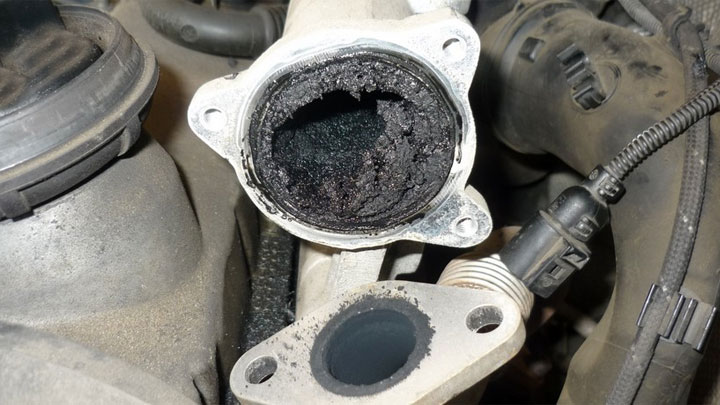P0401 Code (Symptoms, Causes, and How to Fix)
The 1970s brought emissions regulations, mandating new pollution-reducing equipment like EGR valves. Though well-designed, EGR systems still have issues and trouble code P0401 is sometimes a result.
This article will go over the common causes of a P0401 code, its severity, and how to diagnose and fix it in a step-by-step manner.

What Does Code P0401 Mean?
Diagnostic trouble code P0401 is used to describe a condition in which the circulatory flow of exhaust gases through an engine’s EGR valve, is below that which is anticipated.
Simply put, an engine’s EGR valve is not recirculating enough exhaust gases into an engine’s intake, as called for by the ECM/PCM.
To better understand this concept, one must first familiarize themselves with the standard operation of an engine’s EGR valve. This valve, contained within an engine’s emissions system, allows small amounts of exhaust gasses to filter into an engine’s intake. These gasses are then burnt, thereby reducing overall emissions output at a vehicle’s tailpipe.
However, like any mechanical device, an EGR valve is susceptible to eventual failure. When this failure disrupts an EGR valve’s ability to feed exhaust gases into an engine’s intake, diagnostic fault code P0401 is logged by a vehicle’s ECM, and a check engine light is illuminated.
A host of rather serious driveability issues can also accompany such a fault, leading to everything from a rough idle, to eventual stalling.
Related DTCs: P0400, P0402, P0403, P0404, P0405
Symptoms of Code P0401

The exact symptoms associated with DTC P0401 often differ on a case by case basis. However, several symptoms tend to be far more prevalent than others.
The following are the most common symptoms connected to DTC P0401.
- Pre-ignition “pinging”
- Reduced power
- Surging
- Rough idle
- Reduced fuel economy
- Stalling
Causes of Code P0401
There are several different issues that can contribute to the onset of an active P0401 trouble code. The majority of these issues tend to be universal, affecting a wide variety of vehicles, no matter the make or model.
The following are several of the most common causes of DTC P0401.
- Clogged or obstructed EGR tubes
- Carbon fouling of EGR temperature sensor
- Faulty DPFE sensor
- Clogged or restricted catalytic converter
- Lack of EGR vacuum
- EGR valve electrical circuit issues
- ECM/PCM-related faults
Is Code P0401 Serious?

DTC P0401 is generally considered to be quite serious in nature and should be addressed at the first available opportunity.
Since code P0401 indicates a failure within a vehicle’s emissions control system, such issues often result in excessive discharge of noxious exhaust output. This, in turn, can lead to failure of emissions system testing, where required by law.
Additionally, DTC P0401 is typically accompanied by a host of driveability related concerns. Rough idle and stalling are both known symptoms of insufficient EGR flow. This poses the risk of becoming stranded or losing power while in transit, thereby creating a significant safety issue.
In any event, the root cause of DTC P0401 should be diagnosed and remedied at the first available opportunity. Doing so minimizes additional headaches, and eliminates a number of safety-related concerns.
If you do not feel confident tackling such repairs on your own, reach out to a trusted service center at the first available opportunity.
How to Fix a Code P0401

The following steps can be followed to assist you in diagnosing and remedying the root cause of DTC P0401. As always, consult factory specific service literature for your vehicle prior to tackling any repairs.
#1 – Check For Additional Codes
Prior to beginning the diagnostic process, it is important to check for the presence of additional trouble codes. Any additional codes that are present should be fully diagnosed and remedied before continuing.
#2 – Inspect EGR Wiring and Vacuum Lines
You will now visually inspect all wiring and vacuum lines that correspond to your engine’s EGR valve. Look for any signs of damage, and make repairs as needed.
#3 – Check For Sufficient Vacuum/Voltage
While using a bi-directional scan tool, command the engine’s EGR valve to the “open” position. The allocation of sufficient control input should then be verified.
For some engines, this input will come in the form of vacuum. For others, positive voltage will power the EGR Valve.
#4 – Verify EGR Temperature Sensor Operation
With the use of a scan tool, check for recorded fluctuations in EGR temperature, via the EGR temperature sensor. Carefully determine whether or not the engine’s RPMs fluctuate upon the opening of the EGR valve itself.
#5 – Remove/Clean EGR Valve
If sufficient control input is being delivered to the EGR Valve motor, yet its function is still limited, EGR removal will be necessary. Once removed, the EGR valve should be carefully cleaned, as should any corresponding EGR tubes.
#6 – Replace EGR Valve/Motor
In the event that EGR operation is still limited or non-existent in nature, replacement of the EGR valve/motor is advised. Follow all factory specific service literature for your particular vehicle, when conducting such repairs.
- P0480 Code (Symptoms, Causes, and How to Fix) - Apr 19, 2024
- Car Temperature Gauge Stopped Working? (Here’s Why) - Apr 15, 2024
- Ignition Coil vs Coil Pack (What’s the Difference?) - Apr 8, 2024
